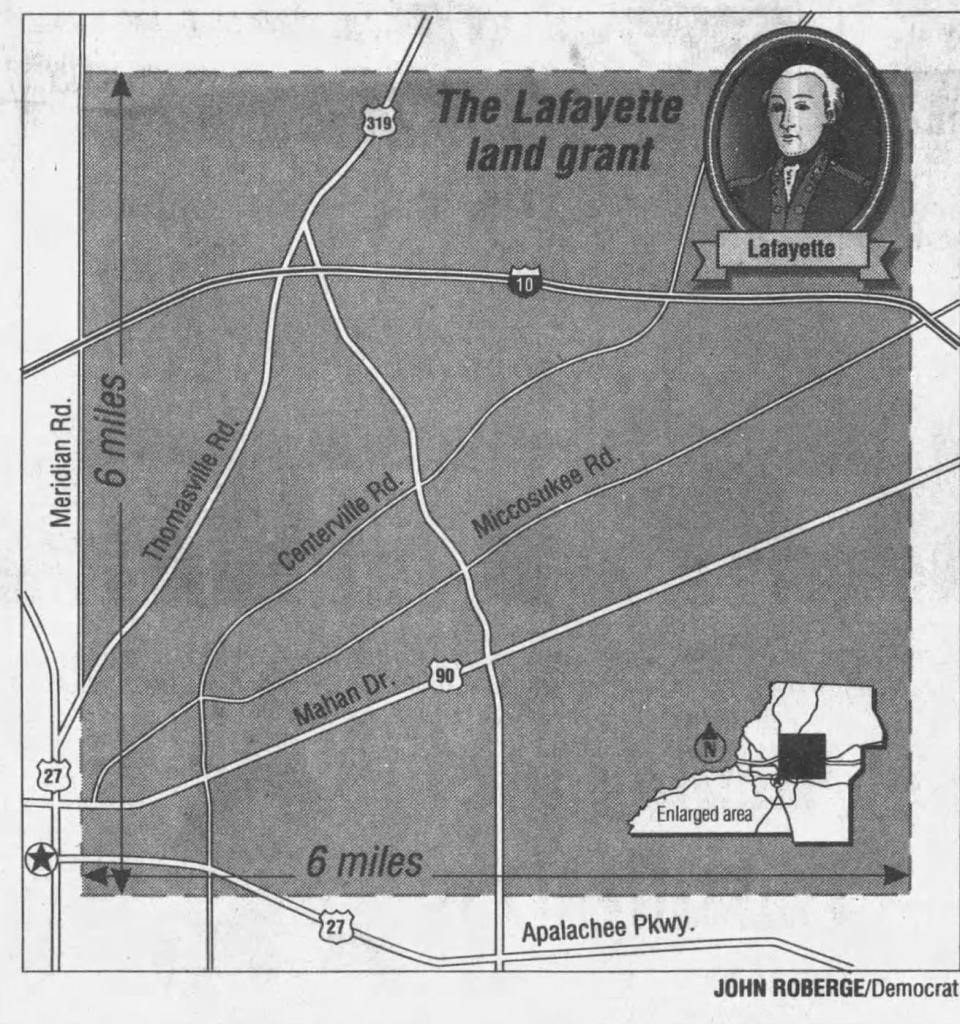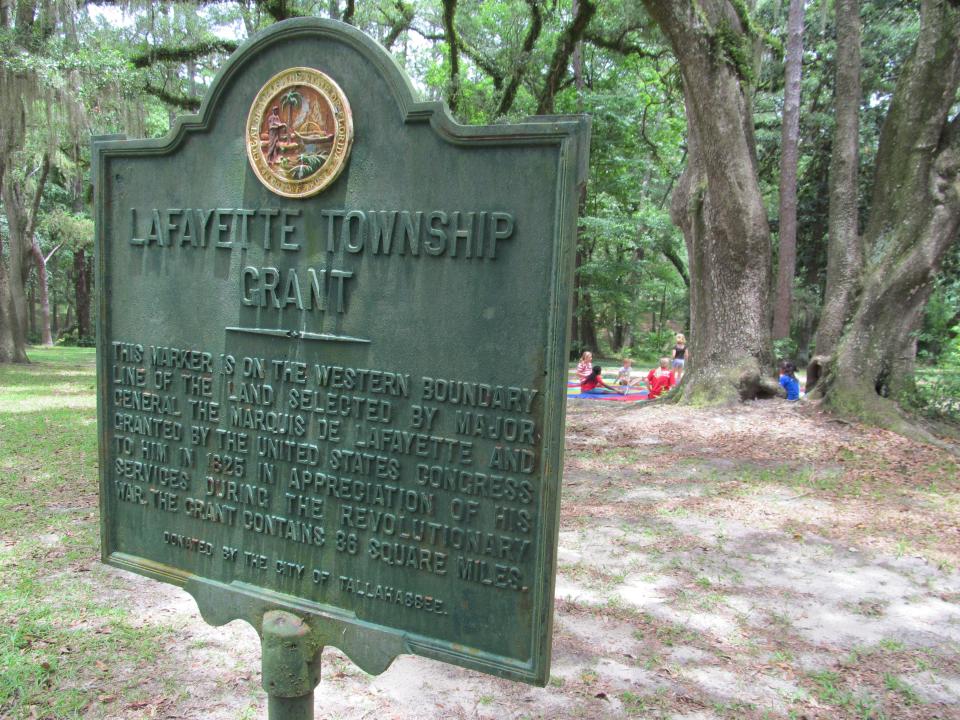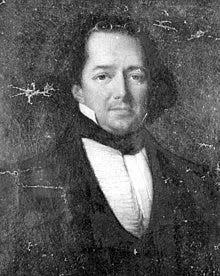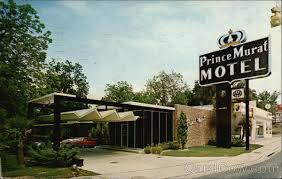Lafayette's Tallahassee and the French influence on Florida's capital city | TLH 200
Lafayette Park’s historical significance goes back hundreds of years, to a time just after the Revolutionary War. The community center and park, located in the heart of Tallahassee’s Midtown neighborhood, sit on land that honors Gilbert du Motier, the Marquis de Lafayette — the French hero of the American Revolution and a man who once owned half of Tallahassee.
The 22-wooded acres are on the western boundary of the Lafayette Grant, which was the 6-mile-by-6-mile township awarded by the U.S. government on July 4, 1825, to Lafayette in gratitude for his service during the Revolutionary War – along with $200,000.
The Lafayette Grant commenced at the corner of Meridian and Gaines streets and extended 6 miles north and 6 miles east. Today, the other three corners of the grant would be Meridian Road/Maclay Road (northwest), the middle of Welaunee Plantation between Centerville and Miccosukee roads (northeast) and the dead end of Weeping Willow Way in Windwood Hills off Apalachee Parkway (southeast).

"In 1831, Lafayette, who opposed slavery, sent three friends and 60 Norman peasants to create a free labor colony on his land. On the banks of Prairie Lake, the colonists planted grape arbors and olive, lime and mulberry trees. But the crops failed, the French farmers were beset by illness and the colony was abandoned in a matter of months," longtime Democrat columnist and historian Gerald Ensley wrote in 2002.
In 1833, a year before he died, Lafayette sold his township for $46,520 to land speculators, who sold it off in pieces.
As the years went by, homes were built surrounding the area in the 1920s, and by 1932, the city decided to turn the land into a park.
Back then, bordered by today's Gadsden, Williams, Ingleside and Martin streets, the land originally included a spring-fed stream and pond for swimming.
“For a period during the Great Depression, the park became a haven for transients and was nicknamed the ‘hobo park,’ Ensley wrote in a 2014 column.
Now, the park has tennis courts, a basketball hoop and trails, and the surrounding neighborhood is one of the most expensive and sought-after real estate markets in Tallahassee.

Signs of French influence in Tallahassee
Lafayette never visited our capital city, but French influence remains.
Frenchtown, the oldest historically Black community in Florida, was originally an area settled by French laborers that Lafayette wooed over from Europe with promises of building a large plantation. When those plans failed, the French left for New Orleans, and formerly enslaved people moved in.
"Legend holds that a few of the colonists remained here, moving to an area just west of the land grant. That area became known as Frenchtown (although some researchers say the name came from a later wave of French immigrants to Tallahassee)," Ensley wrote. "By the 20th century, Frenchtown was the heart of Black commerce and residence, and despite changes in recent years, Frenchtown remains synonymous with Tallahassee's Black community."
They opened businesses, built churches and opened schools, including Lincoln High School, which was built in 1869. Located on Copeland Street and Park Avenue, the old Lincoln was one of two schools opened by the Freedmen’s Bureau in Florida.
The most famous Frenchman?
By the time he died, Lafayette was arguably the second-most-famous French name in Tallahassee.

Prince Achille Murat, the nephew of French Emperor Napoleon Bonaparte, was a Tallahassee planter and famously eccentric character in the early 19th century. In 1826, he and his newlywed wife Catherine Willis Murat, the great grandniece of George Washington, were one of Tallahassee's first celebrity couples. Their’s was only the eighth recorded marriage in Tallahassee's short history.
According to Ensley, Murat became famous for throwing lavish parties and eccentric habits.
"He walked around with a live owl on his shoulder and liked to prepare odd dishes such as cow's ear stew and grilled buzzard," he wrote.
"Once, Murat challenged Judge David Macomb to a duel. Macomb, who had organized the city's first Fourth of July celebration, refused on the grounds that dueling was illegal. The public ridicule over refusing drove Macomb from town, though his name remains – more irony – as the name of the main street in Frenchtown."
The Florida Historical Society, however, noted that a duel did happen when the two met near a lake after Murat called him a "turncoat" at a political rally.
"Murat’s shot went through Macomb’s shirt without touching flesh, and Macomb’s took off half of the little finger of Murat’s right hand," according to the group's historical quarterly from January 1954. "Murat then exclaimed: “Ah! Mr. McComb, you have made one mark on me I will have all my life.”
"Later the participants discovered that Mrs. Macomb, whom Murat, in his Gallic English, described as 'one admirable woman,' had been a witness to the exchange of shots. A gossip had told her that her husband would not fight but rather would back down," the article continued. "To this allegation Mrs. Macomb had replied, 'Never,' and had then set out on horseback to the site of the duel, where from the shelter of some trees she witnesses the proceedings. In describing the incident Murat later exclaimed, “Mon Dieu, I believe if her husband had back [sic] down, she would have shot him, and then shot me.“

Murat and his wife are buried in St. John's Episcopal Church Cemetery. The Tallahassee house his widow lived in for 20 years after his death, Belle Vue, is on permanent display at the Tallahassee Museum.
One of Tallahassee’s most iconic landmarks where Thomasville Road and Monroe Street intersect was the Prince Murat hotel, which when it opened was “the most modern and snazziest of the then-17 hotels in Tallahassee,” Ensley wrote.
The hotel changed to a Budgetel Inn and Suites in 2015, but the nostalgia lives on. The Prince Murat name charmed visitors to Tallahassee and helped make the motel a popular overnight stop for decades.

This article is part of TLH 200: the Gerald Ensley Bicentennial Memorial Project. Throughout our city's 200th birthday, we'll be drawing on the Tallahassee Democrat columnist and historian's research as we re-examine Tallahassee history. Read more at tallahassee.com/tlh200. Email us topic suggestions at [email protected].
This article originally appeared on Tallahassee Democrat: Tallahassee's French connection: Lafayette, Murat, Frenchtown and more
